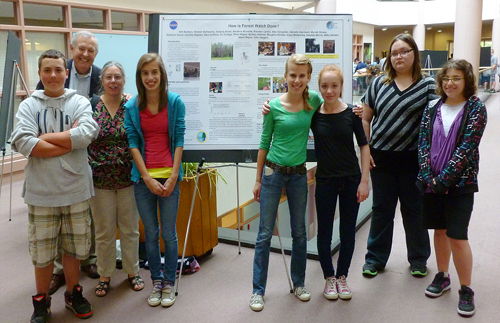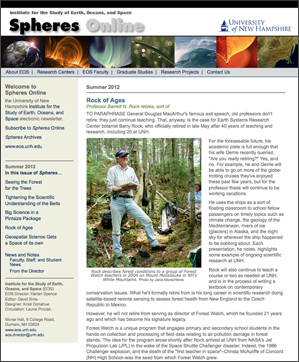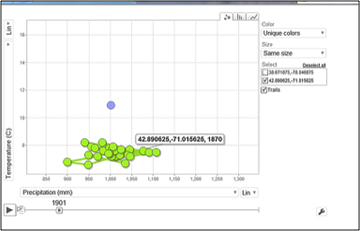October 2012
New TeachersTEN TEACHERS from Maine, Massachusetts and New Hampshire attended a three-day workshop at UNH this August to learn how to bring Forest Watch to their schools. Already these fine educators are establishing study sites and teaching their students about the connections between white pines and ozone.
Check out the gallery of photographs taken by Kristi Donahue. They introduce the teachers as they learn about pine needle anatomy with Martha Carlson, Forest Watch coordinator.
The new teachers will bring 55 new trees into Forest Watch studies!
New Technologies HOW LONG is that pine needle? How much area does a maple leaf have? What colors can we "see" in a leaf or needle? Calvin Diessner introduced Forest Watch teachers to Digital Earth Watch software now available on-line for free through the UNH Picture Post website, http://picturepost.unh.edu/stuffYouCanDo.jsp.
ANOTHER AMAZING SITE just coming on-line allows students and teachers to track climate change in your school's location. Compare different models. Look into the future. Mary Martin and Annette Schloss are developing the Student Climate Data project with a NASA grant in the Institute for the Study of Earth, Oceans and Space. Try it yourself at http://studentclimatedata.sr.unh.edu/.
BEST OF ALL, express yourself and connect with other Forest Watch friends on our new Forest Watch BLOG, http://forestwatch-blog.sr.unh.edu/wordpress.
Student ConventionFIRST THEY met Dr. Rock and other scientists like cosmic ray physicist Andrew Jordan. The kids danced with Marty Quinn’s light show around solar coronas and saw the Geographic Information Lab with 3D maps. “I want to be a physicist,” the kids said.
Then they visited the Jere A. Chase Ocean Engineering Lab, meeting scientists who design and build robotic submarines and map the floor of oceans. “I want to be an oceanographic engineer,” students sighed.
And finally, they met the chef at Hollowayl Commonsl. Ralph Coughenour wore a white tunic and an impressive toque. "I want to be a chef," students said.
Students from Gilmanton School and Josiah Bartlett School also showed off their posters of research in Forest Watch.
 |
|
 |
|
Treats for Teachers
ON JUNE 21, Forest Watch invited teachers to visit for a day of science treats.
The day exploded when Dr. Michael Palace introduced Dr. Crystal McMichael, a new post-doctoral fellow in the Institute of Earth, Oceans and Space. McMichael just published her PhD research in Science, the world's leading scientific journal. She had just arrived from the Florida Institute of Technology to work with Palace. They both told our teachers about terra preta, black earth that marks the gardens of heavily populated communities along the Amazon River, perhaps 500 years ago. McMichael was grinning ear to ear.
Teachers then visited Dr. Ruth Varner's laboratory to see her undergraduate and graduate students turning bright orange oil funnels into floating laboratories. The Varner team was preparing for a trip to northern Norway where they set out the funnel in thawing perma-frost bogs to capture and measure methane. The methane research will help us to understand climate change.
Last but not least, the teachers generously donated their fingernail clippings to Dr. Erik Hobbie and his PhD student Andrew Quimette. The Hobbie isotope lab examines nitrogen and carbon isotopes to learn whether we are wild carnivores, vegetarians or people who eat lots of corn-fed meat products. Such research helps Hobbie explain his research into the isotopes in bog vegetation and fungi.
 |
|
There was fabulous food, music by Forest Watch teacher Louise James and her friend Linda…., a collection of photographs including a young Barry in his first space suit, and a beautiful Forest Watch walking stick made by Mike Gagnon.
Read David Sims' great tribute to Barry in the EOS Spheres newsletter at http://www.eos.unh.edu/Spheres_0812/rock.shtml
Barry continues to direct Forest Watch, to teach two courses and continue his research. But he says he's retired. We wonder…
Forest Watch Fund FOREST WATCH can now receive gifts from private individuals. In honor of Dr. Rock's retirement and 22 years of service with Forest Watch, the University of New Hampshire has established the Forest Watch Fund.
Details about both schools’ work can be found in Chapter 6 of the new Data Book.
Colleagues and friends launched this unique treasury with over $1,000 in donations. These funds and other small gifts will go into immediate activities as we partner with schools across New England.
Our dream is that someone or several people or corporations will contribute $50,000 or more to turn the Fund into a permanent endowment.
Learn more about Giving...
Maple Watch PilotTeachers from schools that do sugaring and schools that hope to do sugaring will meet at Hubbard Brook Experimental Forest on November 12 to brainstorm how to share curricula and mesh their programs with Maple Watch.
Martha Carlson's PhD research has identified three or four simple measures of stress that can help us build a long-term study of maple tree health. All of the different tests a maple undergoes in one year can be averaged to produce a Maple Report Card.
The "grade point average" for a maple can be tracked year to year to see if a tree is healthier or less healthy. And the Maple Report Card can be paralleled with NASA's Common Sense Climate Change Index. So far, Martha believes that when climate temperatures warm up, maple grades will go down.
Off to AGUOur Forest Watch/Maple Watch team will present a poster and/or workshop in San Francisco this December at the American Geophysical Union's Conference, one of the largest gatherings of scientists in the world. Our team will talk about engaging teachers, sugar producers and citizen scientists in studies of maple health and climate change. Ann Diller, a professor of educational philosophy, has helped Martha consider how we confront the ethical and normative issues raised by climate change. AGU had no reference word for "philosophy" in its catalog.
Annual WorkshopForest Watch will hold its annual workshop on January 28, 2013. We will review recent findings that fungal pathogens have caused needle cast in Vermont and northwestern New Hampshire. We'll discuss whether air pollution has contributed to the pine's susceptibility to the fungi.
Learn about 2011 research findings. Meet teachers and scientists. All at Morse Hall, UNH. Email us at forestwatch.unh.edu to register.
 |
 |
|
